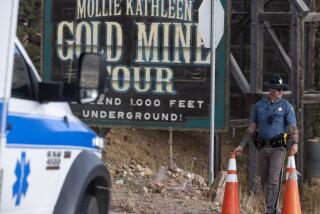Ups and Downs
Elisha G. Otis waved to the crowd and climbed onto the large wooden platform. Workmen strained at a thick cable to hoist him high into the air, the crate riding up between two vertical rails. Then the inventor, wearing top hat and long coat, ordered the cable severed.
The platform did not fall, but hung suspended between the two rails. A pair of spring-loaded devices had automatically engaged the cogged guide rails when the tension of the hoisting rope was released.
Otis performed his stunt over and over again at the 1853 Crystal Palace Exhibition in New York City, thereby popularizing the elevator as a safe means of moving people up and down. By allowing even the least athletic workers to reach upper-story offices, the invention helped make possible the six- and 10-story, cast-iron frame buildings that within four decades scraped the skylines of Chicago and New York.
Elevator experts like to proclaim that, based on the likelihood of an accident during any given ride, their industry offers the safest form of mass transportation known to man. California’s 68,000 elevators--roughly a tenth of the nation’s total and a fiftieth of the world’s--were the scene of just a dozen accidents last year--none fatal.
Accidents tend to be flukes rather than the result of any persistent safety hazard, said Dick Jones, senior engineer and head of the elevator unit in California’s Department of Industrial Relations. “You have to look at each one, why it happened, and we can’t see any trends.”
Serious injuries and deaths during elevator accidents are often the result of passengers’ prying open the doors of a stuck car and trying to jump down to the nearest floor, only to stumble and fall to the bottom of the shaft, said Floyd J. (Bud) Rommel, chief elevator inspector of Arizona and executive administrator of the Phoenix-based National Assn. of Elevator Safety Authorities. In 1983, the American Society of Mechanical Engineers amended its national code for elevator design to require the use of so-called restrictors that make it virtually impossible to open the doors of a stalled elevator from the inside.
After a slow start, Los Angeles has moved up quickly to become the nation’s second-largest elevator modernization market, trailing only New York, said Donald W. Brooks, vice president for new products at Schindler Elevator.
The popularity of modernization tends to parallel the health of local office space markets and the pace of business life. While New York races along and Los Angeles accelerates, business in Chicago is slow and Miami’s market for modernization is “most absolutely dead,” Brooks said.
And the Lone Star state? “Texas? Where is that? Texas is about as dead as you can get because there’s so much vacant (office) space.”
From fire alarms to toilets, most products used by consumers are tested extensively in laboratories. But an elevator does not exactly fit in your average lab.
Elevator research towers that begin to approach the Washington Monument in slenderness and height seem to be the answer. Otis Elevator has just opened a 29-story tower in Bristol, Conn., that contains 11 elevators shafts. The shafts range from 30 to 300 feet and can be used to test everything from hydraulic elevators for low, suburban office buildings to swift, gearless elevators for high-rises.
Flexible work schedules are a boon for employees who like to rise extra early so as to beat the morning rush hour. But they are a nuisance for elevator designers.
Elevators handle the morning crunch most efficiently if they do not have to make stops to pick up passengers on the trip down to the lobby. So while zealous executives who come in at 7 a.m. may think they are doing their company a favor, their traveling up and down the building for power breakfasts and early meetings may actually slow the arrival of more laid-back colleagues.
More to Read
Sign up for Essential California
The most important California stories and recommendations in your inbox every morning.
You may occasionally receive promotional content from the Los Angeles Times.









